Window Replacement vs. Window Reconditioning
(Not an “apples to apples” comparison)
Should I replace my old windows or attempt to save them? This has been a growing uncertainty since the 1950’s when replacement windows were a new product making salespeople a fortune. As this trend became more popular, it became common to use replacements for both old and new homes. Alongside this spread of “maintenance free convenience” came the vast decline in the knowledge of how to maintain old windows.
If a window is old enough, restoration and protection is ALWAYS possible. Once you learn how windows were built before the replacement era, it becomes obvious why keeping old windows is desired. Unfortunately, this information isn’t easily available, and the modern window salespeople lose business if you find out. Older windows are simply more durable, beautiful, and effective than windows pushed today.
Learning about old windows can take a little effort. Nobody wants to make decisions they will later regret, so it’s important to do your due diligence. As you consider a window project, make sure to get information from a variety of sources. As a qualified authority in window restoration, we aim to provide reliable information to enable an informed decision.
This article was written for all property owners with windows built before 1960. If your windows were built between 1960 and 1990 this may apply to you as well. If you aren’t sure, just call us. Our restoration team can help you determine if your windows are worth saving.
Marketing Misconduct:
New marketing ads are written every day to sell modern windows. Big companies have deep pockets and keep the internet flooded to drown the competition. Every keyword slightly related to windows is used by replacement companies to keep people focused on them. When a homeowner tries to search for restoration services it’s not always easy to find professionals who do the work.
Ads for restoration are used as bait to get searchers on a replacement companies’ website. Once you’re on the website, they have a chance to convince you to follow their sales process. As we have all seen, a good lie often includes elements of the truth. We commonly see incomplete information about restoration combined with misrepresentations. This often precedes a recommendation for replacement.
Case in point: A blog on the Window World website entitled “Replacement Windows for Older Homes” from 6/6/2019 states the following: “Restored older windows will still block most drafts when paired with a storm window… …However, not all historic windows can be restored. If any of the wood around the window is rotting, there is no turning back. Luckily you have the option to replace…”
Rot isn’t a reason to throw out a historic window. It can be repaired and prevented relatively easily when you work with someone who knows what they are doing. It’s possible some of these modern window companies don’t know they are spreading misinformation. It’s also possible some know perfectly well yet do it anyway.
You may be glad to discover that damaged, stuck, and deteriorated, “single pane” style windows can ALWAYS be fixed. They can be made just as efficient(or more) and will last many times longer than their modern counterparts. If you find yourself being advised to replace your old windows, hesitation is a good instinct.
To make a truly informed decision, it is important to consider the alternative solutions related to maintaining and reconditioning. The modern window people are only experts at convincing people to replace windows. When it comes to the care of old windows, they are likely complete amateurs.
The first step in understanding the value of your old windows is to learn which facts the salespeople leave out.
The Efficiency Half-Story:
One of the most common reasons people get sold replacement windows is the higher efficiency of double pane insulated glass compared to single pane glass. This is technically a true claim if nothing else is considered. We all know glass is not a great insulator by itself. Just think of how it feels to hold an ice-cold glass of water in your bare hand. Now, let’s consider what’s usually not mentioned by the salespeople.
In double pane glass, the gap between the two panes slows the rate that heat/cold radiates through. The air gap acts as a thermal barrier because air changes temperature slower than glass. An old window with single pane glass, can achieve this ability by adding a quality storm window. The storm should be measured, ordered, and installed by an old window expert who specializes in storms. This addition makes the opening at least as efficient as modern insulated glass.
Storm window efficiency can be further increased by using Low-E glass in storm windows. Low-E glass reflects a significant percentage of heat. During the summer, heat outside is reflected away from the house keeping the house cooler inside. During the winter, heat inside the house is reflected back inside keeping the house warmer.
Furthermore, we find an even greater culprit of inefficiency is from leaky gaps around the sides of a window sash. Drafts coming through these gaps makes a home much less comfortable. Even brand-new modern windows can have this issue if they are cheaply made or cheaply installed. When properly attached to the window casing, a storm window seals off the typical sources of drafts. This allows the homeowner to better regulate the temperature and keep the inside comfortable with less energy usage.
Older window sash can become more efficient by adding a variety of methods of weather proofing. Interlocking weatherstrip, bulb seals, and dust blocks are common methods to further insulate an old opening. The weatherstrip can even make the window slide more smoothly.
An even greater culprit of inefficiency is from leaky gaps found around the sides of a window sash. The drafts coming through these gaps are what makes an old home much less comfortable. Even brand-new modern windows can have this issue if they are cheaply made or cheaply installed. When properly attached, a storm window does the best job of sealing out drafts. This can make old windows even more efficient than modern windows.
As a final point, the window sash itself can become more efficient by adding a variety of methods of weather proofing. Interlocking metal weather strip, bulb seals, and dust blocks can further insulate an old opening. Weather stripping a window can even act as a track and make it slide more smoothly.
The Tilt-in-Cleaning Half-Story:
Another selling point of modern windows is tilt-in-cleaning. It’s easy for a window salesperson to look at an obviously dirty window and start their pitch. Often an old window is painted shut, or a fixed storm panel is in the way so cleaning can’t be easily done. This makes tilt-in windows seem like the better choice in the cleaning category, at first.
As with all parts of a modern window, the tilt-in-cleaning feature only works as long as the tilt in mechanisms work. If part of this breaks, you might have to be lucky to find replacement parts. If the company out of business, or the model is discontinued, you may not be able to find what you need.
This leads to another thing that commonly goes undiscussed with modern windows. The nearly impossible to clean space between the panes of modern double-pane glass. When the insulated glass unit fails and fogs up, the window can’t be easily cleaned again. Usually by the time this happens a modern window has multiple failures, and the only practical solution is replacement.
These situations are easily solved with older style windows because(again) they can always be repaired. Cutting them loose and restringing lets you move the sash around for easier cleaning. Every part can be individually serviced or replaced with common materials. Many windows can even be modified to make cleaning even easier if desired. If your old storms don’t open, you might consider getting some that are designed with cleaning in mind.
What is The Real Value of an Old Wooden Window?
When building a wooden window from scratch with quality materials in the old style, the cost for the client can easily exceed $4,000 on a simple, average sized window. If we get further into the variety of sizes, styles, and options like; curved or peaked arches, alternate glass types, unique operation, stained grade finishes, antique hardware, etc., the sky becomes the limit. Most old solid wood windows are highly valuable while still in place. This is in part due to the quality of the craftsmanship and materials they were built with, but more importantly because of this fact:
Every component of a solid wood window was designed to be serviced, repaired, or replaced without destroying the entire unit.
In contrast: Replacement windows are intentionally designed to be UNserviceable.
This has become standard practice in the replacement window industry and continues to create returning customers. Manufacturers like Anderson windows even say on their website that the typical modern “maintenance-free” window lasts about 20 years. Key components of these windows are built with materials that degrade with time, so they inevitably fail. The irony of maintenance-free typically reveals itself when an attempt to repair causes further damage.
“Maintenance-free” actually means “Can NOT be maintained”.
Good luck in finding someone willing to try to fix a broken modern window. Experienced handymen know better because they have tried in the past with unsatisfactory results. Inexperienced handymen may agree to try, but they will quickly learn why this requested work gets turned down.
You could try to hire a contractor to replace the whole window, but contractors often have fixed project costs and/or minimum job sizes. This means you may not be able to find anyone to do the work for a reasonable cost. You may have to wait until you have enough broken windows on your home that it’s worth their time or pay extra to cover their fixed project costs.
Do My Windows Really NEED Restoration?
Full window restoration is highly specialized and labor-intensive work that is NOT needed on most window sash. This is especially true when using quality storm windows. The protection provided by a properly installed storm window often eliminates the need for many of the weatherproofing steps required when preparing a window to withstand the elements on its own.
Here is an informative diagram of a double-hung window that shows how well they were designed:
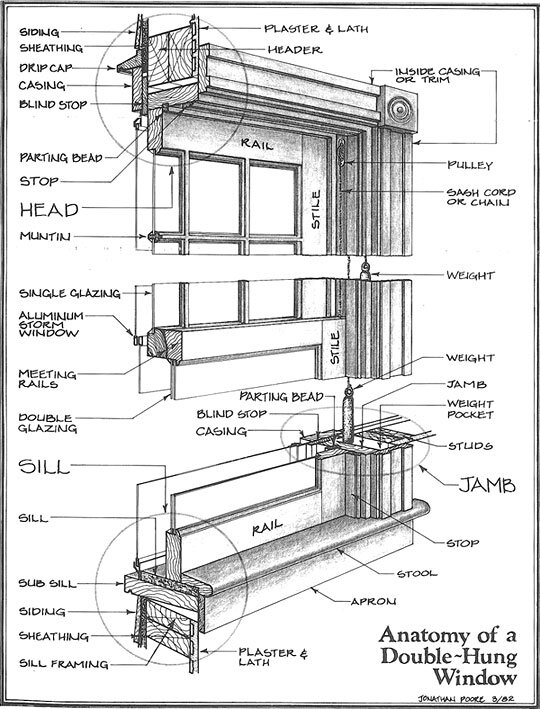
On the exterior(left) of the window in the picture above you can see the storm window. It protects all the wooden parts of the window from top to bottom. Storm windows are an important option to consider when comparing old windows with modern replacements.
Homeowners often call us for a second opinion after being told their windows need replaced by a remodeling contractor. We usually discover that their windows are in pretty good shape and are simply due for the normal paint/glazing and/or mechanical maintenance they were designed to receive. Even rot and sun damage can be fixed by a trained specialist. Often, we find they aren’t due for any repair at all and are just dirty.
Replacing old windows in this condition is like throwing a stack of dirty old $100 bills in the trash to fit a stack of clean new $10 bills in your wallet.
A salesperson recommending the replacement of hundred-year-old windows is like a Doctor who prescribes treatment when you have no health problems. Even if there are symptoms, the treatment should always fit the ailment. If the doctor finds the patient has elevated blood pressure, and their first recommendation is heart replacement surgery, it’s time to consult a different doctor. We believe that before you jump into the replacement cycle it is wise to consider the less invasive options first.
Based on our experience as a qualified authority in historic windows, we recommend:
“If it ain’t broke, don’t fix it, but even if it is, don’t replace it.”
If your windows look rough and you are starting to investigate your options, here is some good news:
You don’t have to feel rushed to complete the last 30-40 years of undone reconditioning and maintenance all at once.
Practical Window Restoration
Often there is no need for us to go into extensive window reconditioning right away. When there is, we have developed a practical method that is much less invasive, and much more manageable over time than replacement. Some steps can make sense to do all at once, and some are better off completed in smaller batches. We commonly discuss phasing options with our clients to design a project that fits what they need. Our usual approach starts on the outside and works towards the inside.
The Importance of Properly Installed, Quality Storm Windows
Storm window protection is sometimes overlooked or dismissed on historic sash and homeowners pay the price through larger amounts of restoration work and high energy bills over time. A smart strategy we commonly use is to have quality storm windows installed before you begin sash restoration work. Quality storm windows will enable the window to:
- To retain its beauty longer
- To retain its structural integrity
- To be energy efficient to modern standards
- To dampen sound transmission
- To decrease the frequency of cleaning
- To decrease the frequency of re-painting/glazing
- To decrease the frequency of window maintenance
- To be protected from vandalism
- To be protected from rot/damage/sun and other deterioration
- To hold its value for longer periods of time
After Storms have been installed, they become the primary weather barrier and put a halt to sash deterioration. This allows the owner to take their time and do restoration and maintenance over time as finances allow for it without feeling rushed. Any sash in need can be removed from the inside, transported to a shop, and worked on without leaving the house open to the elements in their absence.

No need to put plywood in your window when the storm is already installed.
Sash Repairs/Restoration:
When it’s time to work on sash in our shops, we commonly get batches from 3-6 openings at a time, but we can take on as many as the budget allows for.
Here is an example of the lower rail of a sash in need of shop restoration:

Even in this kind of condition, an old window has value. This wooden window has been exposed to the elements with no storm window for some time. Notice the bottom rail is held on with 3 L-brackets and even so is pulling apart. After spending some time in the shop, this window will look brand new.
Here is a dismantled sash in the middle of the repair process:
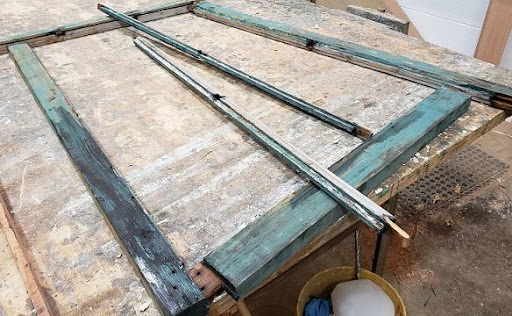
We can take old windows completely apart, fix any damage, and put them back together again.
Here is another sash after repairs, and before it hits the paint shop:
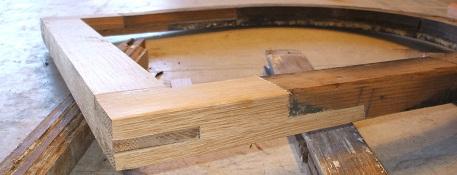
The repair we complete depends on the style of window and what condition it’s in.
After completing our process, old sash can be restored to look like new:
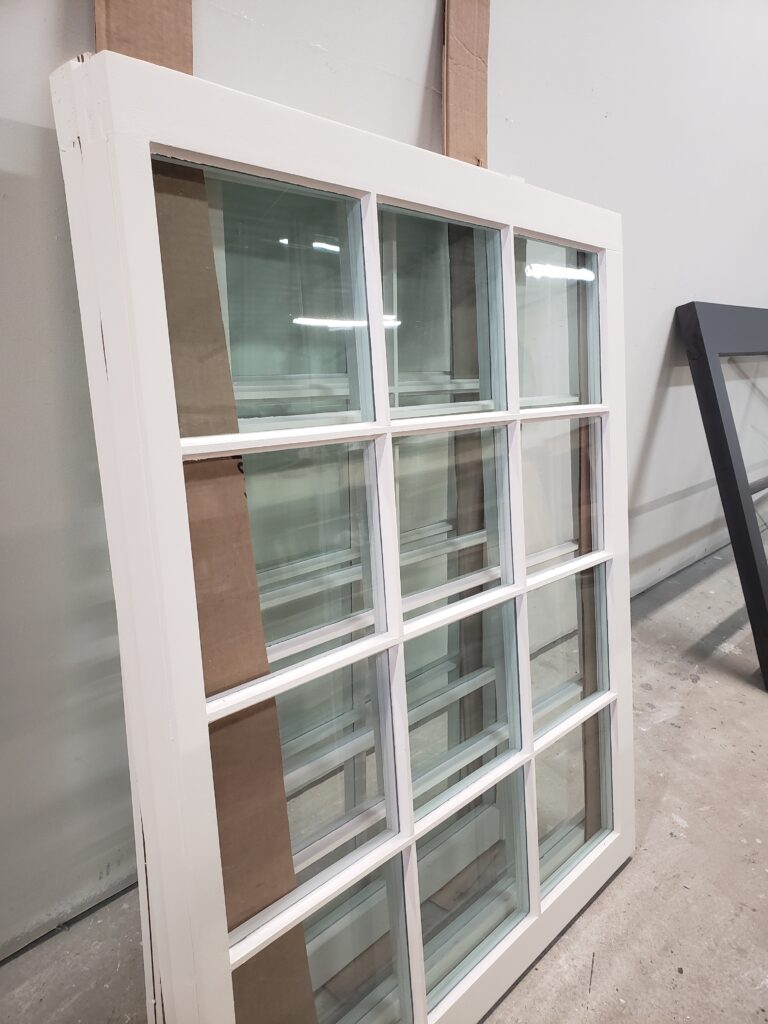
Before and After
The difference in before and what is possible after can be huge on some projects:
In the hands of a qualified restoration specialist, windows in any state of disrepair can be fixed.
With a combination of old window restoration and quality storm windows, a lot can be done to sharpen or freshen up the look of your property.
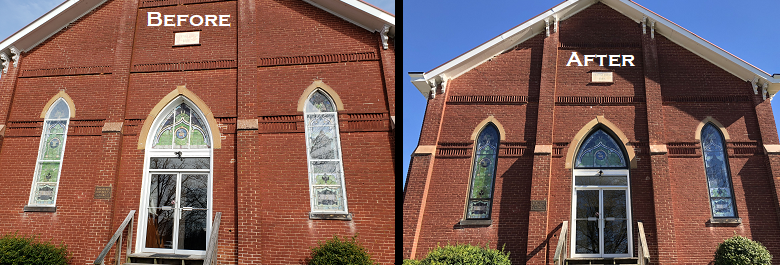
Can My Windows be Saved?
If they were built before 1960 the answer is a resounding YES!
From the 60’s through the early 90’s it depends on how they were built.
If they’ve been built since the 90’s, the answer is almost always no.
A visit from a qualified member of our team can help you determine if your windows need repairs or only simple maintenance or cleaning. Even if your windows are damaged it’s usually less expensive in the long term to have them repaired as opposed to locking yourself into the permanently repeating costs of the replacement cycle.
What is the Replacement Cycle?
Many contractors these days push modern replacement windows as “affordable”. It may seem appealing because their price can initially sound pretty good, but they all come with the tradeoff of that repeating cost every time you have to buy again.
Sold as the most affordable, a vinyl windows at +/- 15 year lifetime can sound like a long time, but it’s the old “kicking the can further down the road” situation. Here is a snippet from an article I found enlightening which describes what happens if you get sold cheap vinyl:
New Windows- Do They Last?
“What we’re seeing today,” Kramer says, “is a lot of homes that were built back in the 90’s to present, with windows that are failing, rotting from the inside out. Many mass home builders use low-end builder-grade windows in new construction to keep costs down, but we’re seeing these windows fail in as little as three years.”
Vinyl windows are cheap because vinyl is plastic, and windows made of plastic do not last long. Other Modern materials like fiberglass and modern wood windows(with and without the metal cladding) might survive a few years longer, but ultimately, they meet the same unrepairable end as vinyl and end up at the dump. When the insulated glass in the window fails, any attempt to take the window apart for repairs will end in a pile of broken parts that aren’t worth putting back together.
Once your solid wood windows are gone, and you’re in the replacement cycle, getting back out is expensive. Having that old style window rebuilt from scratch with quality materials will cost a lot more than replacing again. This is why once started, the unfortunate cycle usually repeats.
Modern window salespeople bank on this and often encourage homeowners to decide to replace based on their sales pitch before talking to a restoration expert.
Environmental Impact:
Since reconditioning a window means keeping most or all the original parts, the impact on the environment is lower than any other modern window.
Old wooden windows that could have been repaired/restored are often sent to the landfill where they end up right alongside the ever-expanding heaps of vinyl, metal, wood, rubber, and glass waste from continual window replacement projects. More new vinyl windows mean more hydrocarbon-based raw materials (petroleum, natural gas, or coal) are required to create the polymers used in manufacturing.
It is often touted that much of this construction waste can be recycled but the reality is that a very small percentage ever sees that end since the cost of recycling can be higher than the cost of buying new.
When manufacturing new storm windows, aluminum is arguably the best material to use for a variety of reasons. It is very common that the aluminum used comes from recycling. Recycling aluminum is over 90% more efficient than making new, so the cost of mining and processing new aluminum ends up being much higher than the cost or recycling. This difference naturally leans manufacturers toward the more environmentally friendly option of using recycled aluminum whenever possible.
The window solution with the smallest environmental impact is to keep the old windows on your house and out of the dump. The strategy of protecting your windows with quality storms and reconditioning as needed has a very low impact compared to the repeating impact of the modern window replacement cycle.

Historical Integrity:
Many communities are governed by an office of historic preservation where homeowners are not allowed to use modern windows because they reduce the historic integrity of the architecture. They require a certificate of appropriateness on all home construction projects which usually will not allow for modern windows to be installed. Quality storm windows have been installed on many famous historical buildings such as Monticello, Yale, Princeton, etc. and are easily approved due to their nature of protecting historic architecture.
When replacement windows are allowed to be installed in an old home, they can decrease the resale value while increasing the time the sale takes. A potential buyer of an old home is usually looking for that certain character of the old style of architecture. It is usually obvious that modern windows don’t fit the old style. A would-be buyer will often move on to find a home with windows that look right on an old home.
Final Thoughts:
For a final bit of evidence, consider the durability of your old windows. They have likely been on your home since it was built, and they are still likely in pretty good shape. Ask yourself how many years that has been. 50? 100? 200? The most expensive replacement windows money can buy today will only last a fraction of that time and lead you toward recurring replacement cycle purchases that will far exceed the cost of taking care of your original windows.
Old homes are often passed between many families over the years. More than just a roof over your head, it can be a great source of learning and can spur appreciation for old building systems that were designed to last for generations. We have found that protecting and maintaining your homes original windows is the most affordable long-term strategy. It’s also the most historically accurate, environmentally friendly, and aesthetically pleasing method. Historic windows will out-last and perform as well or better than anything the modern replacement industry can offer.

